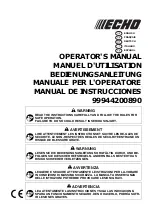
23
Forced Draft Unit Capacity Control
The most common methods of capacity control are cycling the single speed fan motors,
using two speed motors or pony motors and utilizing variable frequency drives to control the
tower fans. Although capacity control methods for forced draft units are similar to those used
for induced draft units, there are slight variations.
The simplest method of capacity control for forced draft units is to cycle the fan(s) on and
off. However, this method of control results in larger temperature differentials and periods
of time with the fans off. When the fans are cycled off, the water falling through the unit can
draw air flow into the fan section. During extremely low ambient conditions, this moist air
may condense and freeze on the cold components of the drive system. When conditions
change and cooling is needed, any amount of ice that has formed on the drive system can
severely damage the fans and fan shafts.
Therefore, fans MUST be cycled during low
ambient operation to avoid long periods of idle fan operation. Excessive cycling can
damage the fan motors; limit the number of cycles to a maximum of six per hour.
Two speed or pony motors offer a better method of control. This additional step of capacity
control will reduce water temperature differentials and the amount of time that the fans
are off. This method of capacity control has proven effective for applications where load
variations are excessive and cold weather conditions are moderate.
The use of a variable frequency drive provides the most flexible method of capacity control
for forced draft units. The VFD control system allows the fans to run at nearly an infinite
range of speeds to match the unit capacity to the system load. During periods of reduced
load and low ambient temperatures, the fans can be maintained at a minimum speed which
will ensure a positive air flow through the unit. This positive air flow in the unit will prevent
moist air from migrating towards the cold fan drive components reducing the potential for
condensation to form and freeze on them. The VFD control system should be implemented
for applications that experience fluctuating loads and severe cold weather conditions.
Ice Management
When operating an evaporative cooling unit in extreme ambient conditions, the formation of
ice is inevitable. The key to successful operation is to control or manage the amount of ice that
builds up in the unit. If extreme icing occurs, it can lead to severe operational difficulties as well
as potentially damaging the unit. Following these guidelines will minimize the amount of ice that
forms in the unit leading to better operation during the cold weather season.
Induced Draft Units
When operating an induced draft unit during the cold weather season, the control sequence
must have a method to manage the formation of ice in the unit. The simplest method of
managing the amount of ice buildup is by cycling the fan motors off. During these periods of
idle fan operation, the warm water that is absorbing the building load flows over the unit to
help melt the ice that has formed in the fill, basin or louver areas.
WARNING
Using this method will cause blow thru, resulting in splash-out and ice formation.
To help
prevent blow thru and splash-out, maintain a minimum 50% fan speed, consult your
local legislation as described in the section “Capacity Control”.
Содержание AT 110-112
Страница 39: ...39 ...
Страница 40: ... 2012 EVAPCO Europe Bulletin 113 E 1216 ...
















































